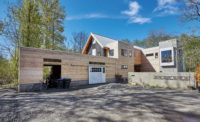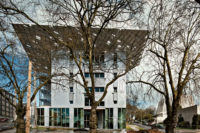Interview with Living Building Challenge Creator Jason F. McLennan

Newsmaker: Jason F. McLennan
Photo © McLennan Design
Jason McLennan says green building is not about putting on a sweater when you’re cold. It is about creating better buildings. For two decades, his mission has been helping the design and construction industry do just that.
Best known as the author of the Living Building Challenge (LBC), a certification system that is widely regarded as the world’s most stringent green building standard, McLennan, now 42, started his architecture career at the pioneering sustainablearchitecture firm BNIM in Kansas City, Missouri. In 2004, he became its youngest partner. But in 2006, hoping to push green architecture further, he left to become CEO of the Cascadia Green Building Council, the Pacific Northwest chapter of the U.S. Green Building Council. From there, he officially launched the LBC. Three years later, he founded the International Living Future Institute (ILFI).
Under his leadership, ILFI introduced a roster of deep-green standards, including Declare, a products ingredients label; a certification for net-zero buildings; and the Living Community Challenge, a planning-scale version of the LBC. He’s the winner of this year’s Award of Excellence from RECORD’s sister publication, Engineering News-Record, for his role in raising the sustainability bar.
In January, he stepped down from his post at ILFI to focus on his architectural practice, McLennan Design, on Bainbridge Island, Washington. RECORD spoke with him about his plans for continuing to push the industry forward.
Architectural Record: You just introduced the Green Warrior Society, a new charitable arm of your firm that will provide architectural services to nonprofits. How will it differ from other pro bono design endeavors?
Jason F. Mclennan: We’re pulling together not just architects but all the disciplines. So it’s an integrated process, with engineers, landscape architects, and construction companies. The effort is meant to match firms with NGOs that are doing good work and have a deep commitment to sustainability. It’s about constructing a Living Building, a net zero energy building, or a LEED Platinum building at a minimum. The idea is that everybody deserves the greenest building possible.
Are you recruiting firms or individuals?
I want commitments from firms. Although there are many that do pro bono work, I’ve heard consistently that they have a hard time managing that work and identifying projects. So it is helpful to have a structure like this. The society will also serve as a peer learning group. We’re going to be in frequent contact with partners like Miller Hull and Lake|Flato to talk about what we could be doing differently. We’ll be getting better at this together.
Your partner at McLennan Design, Thomas Knittel, is continuing the orphanage project in Haiti that he started at HOK, the William Jefferson Clinton Children’s Center. Will it be completed as a Green Warrior project?
That’s how we’re looking at it. We had to redesign it for a new site, and we consider that part of our piloting process.
Tell me about McLennan Design’s eco resort on Blackadore Caye, off the coast of Belize. Do you have any misgivings about bringing tourists there?
If people don’t do something, the island is going to be gone and the entire ecosystem with it. So actually there has to be an intervention. Definitely there’s a carbon footprint for flying, but people have to vacation somewhere, and I’d rather they do it in deep-green buildings.
Why would Blackadore disappear?
People have completely stripped the island of its mangroves. There are changes in sea level, and the island’s other trees can’t stand the salinity. They’re dying, and the whole system is in rapid decline. This is the story of islands all over the world, where humans have changed the way that their systems work.
I’ve heard that you plan to start a design school. Is that so?
Yes. We just purchased a small historic building on Bainbridge Island that we will transform into a Living Building. We’re going to be taking students from different design schools for a semester to a year. They would get credit from their home institutions and a deep dive into regenerative design thinking. Was it always your plan to someday return to practicing architecture? Yes. My goal was not to run a nonprofit. My goal was to create change. The team at ILFI is now really strong. I can continue to help transform the industry by designing Living Buildings and staying on the cutting edge myself.




